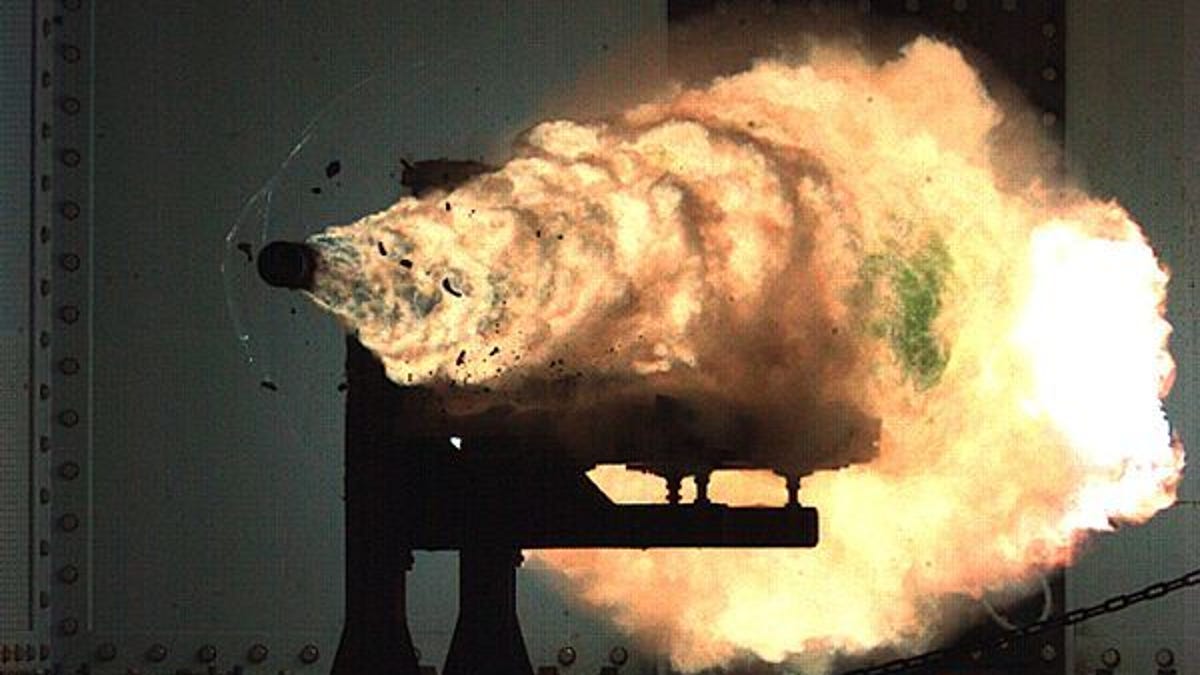Futuristic Navy railgun with 220-mile range closer to reality
A $10 million contract with Raytheon for the Pulse Forming Network means that the newfangled weapon system, which uses electromagnetic energy instead of explosives to fire, is one step closer to deployment.

Imagine a Naval gun so powerful it can shoot a 5-inch projectile up to 220 miles, yet requires no explosives to fire.
That's the Navy's futuristic electromagnetic railgun, a project that could be deployed on the service's ships by 2025, and which is now a little bit closer to reality with the signing of a deal with Raytheon for the development of what's known as the pulse-forming network.
Rather than using explosives to fire projectiles as do conventional naval weapons, the railgun depends on an electromagnetic system that uses the ship's onboard electrical power grid to fire the gun. The pulse-forming network is a system that stores up electrical power and then converts it to a pulse that is directed into the gun's barrel, explained John Cochran, the railgun program manager in Raytheon's Advanced Technology Group.
Essentially, Cochran continued, the process is akin to that of a car's starter, and how turning the ignition sends a jolt of electricity into the solonoid, which then creates a magnetic field in the solonoid/starter system. With the railgun, he said, current is sent into the barrel, forming a magnetic field, and that, in combination with the current, exerts force on a projectile, firing it out of the barrel. At Mach 0.75.
While Raytheon has scored the $10 million project to develop the pulse-forming network, it isn't the only contractor working on such a system. According to Roger Ellis, the program manager for the Railgun program at the Office of Naval Research, the Navy has awarded similar contracts to BAE Systems and General Atomics in a risk-reduction strategy that counts on having multiple contractors attacking a problem in order to arrive at the best possible technology.
Safety
One of the main reasons behind the Navy's railgun program is that being able to power the gun electromagnetically is seen as much safer than having to use conventional explosives.
At the same time, because the power for the railgun will come from ships' standard battery banks, the Navy shouldn't have to maintain large amounts of space on board for storage of the explosives traditionally used to fire big guns. Still, that's an issue that hasn't entirely been solved yet, Cochran said. "The main challenge is to get large amounts of energy being stored into smaller and smaller packages," Cochran said, "such that they can be used in a modular and versatile way for multiple platforms."
At the same time, Raytheon and its competitors have to convince the Navy that they've solved all the potential safety problems that can come from having high voltage and high current in close proximity.
Multimission capability
The Navy began pursuing the railgun in 2005, and for now, there are only lab prototypes of the weapon. But already the Navy has set a world record (see video below) for muzzle energy used in a weapon--33 megajoules. According to Defense Market, a shot of that magnitude could potentially reach "extended ranges with Mach 5 velocity."
However, Ellis said, the Navy has awarded contracts to BAE and General Atomics to build prototypes that "are more tactical in nature."
And when the railgun is finally deployed, it is likely to be used--or at least be ready for action--in several different kinds of missions. First, Ellis explained, it could be used from a ship to fire inland in support of marines as they come ashore.
At the same time, because the weapon's range is so long, it could allow a Naval ship that features the railgun to defend itself from sea-borne threats long before it can itself be attacked, or from missiles fired from land or sea.
Now it's on to the next phase of the project. According to Ellis, that phase includes demonstrating that it's possible to fire a railgun at a rate of 10 rounds per minute, as well as doing new kinds of thermal and cooling tests. Ellis also said that while the Office of Naval Research has said that the railgun could be ready by 2025, that timing is when the work on the science and technology side of things could be done. Actual deployment could take longer owing to financial and political considerations.

